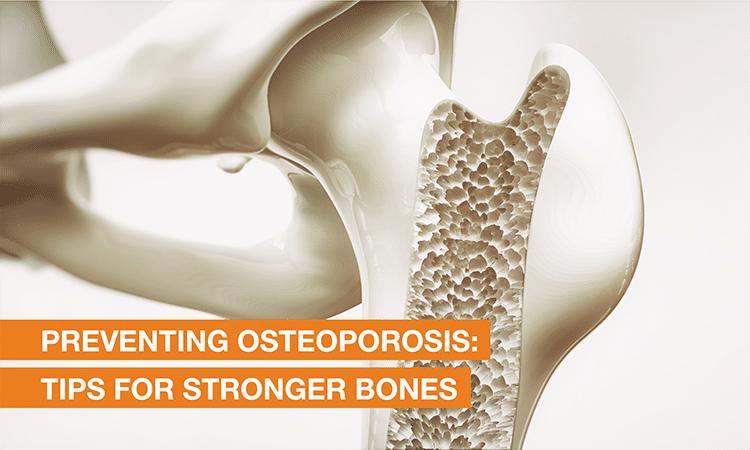Request Appointment
Enter your details and we will be in touch with you shortly;
Or call
8655885566
between 8 am and 8 pm.


Unlike common notions, bones are living tissues that the body constantly breaks down and renews. It reaches its peak during adulthood (25 to 30 years) and begins to lose density as you age. Out of the many issues that affect the spine, Osteoporosis is one of them and is considered a ‘silent disease’. It often doesn’t show any symptoms and rather you would discover it only after getting a fractured bone. Although age, sex, and lifestyle among others can cause Osteoporosis, it is preventable if you take action before it’s too late. Let’s take a deeper look to find more.
Osteoporosis translates to ‘porous bone’ that occurs when the body is unable to replace the broken bone with a renewed bone faster enough creating pores in the bone. It makes the bone brittle since the bone is losing its mass. Additionally, it begins getting progressively weaker thereby escalating the risk of fractures.
Unlike muscles, bones may seem like they don’t need nutrients and minerals to stay healthy. However, bones are made up of specialised cells that require adequate minerals to keep them healthy throughout their lifespan.
Just like RBCs in your blood, bones are broken down and renewed around the clock. Bones reach their peak mass around 25 to 30 years of age. Once it attains its peak, it begins to deplete. This is often contributed by poor lifestyle, lack of exercise, and lack of calcium and other minerals. Similarly, some internal reasons contribute to bone loss such as age, sex, and depletion in sex hormones such as estrogen (female) and testosterone (male) among others.
Women are more susceptible to developing Osteoporosis postmenopausal since they begin losing estrogen levels that directly link to loss of bone mass.
Osteoporosis can lead to problems such as fractures due to brittle bones thanks to low bone density. More conditions that can result from it include Dowager’s Hump, loss of height, change in posture, and abnormal bending of the spine called Kyphosis.
Osteoporosis could happen due to several reasons. Those with a body mass index of 19 or less are susceptible to this condition. High thyroid hormone can aggravate bone loss. Similarly, bones become weaker and thinner as you age. Other factors include alcohol use, tobacco, family history, genes, eating disorders, certain medications, etc.
Your bones are living tissue made up of specialised cells. As you age, these cells form bones and you reach a peak in your 30s. Bone density determines how porous your bones are. Under a microscope, your bones are sponge – like with small holes spread across the length and breath. Put simply, the more holes in your bones, the less dense it is.
Maintaining adequate bone density is crucial as these are tasked with supporting your weight as well as any and every activity you do. Bones with less density won’t be able to support your body and that increases the chances of falling and fracturing that particular bone which can render you immobile until it recovers. Osteoporosis is a condition wherein your bones lose density making them susceptible to break easily. On the contrary, maintaining a healthy bone density supports the weight of your body as well as the activities you do without breaking.
Older folks are at an accelerated risk of developing Osteoporosis. Similarly, gender is an influencer since women are more susceptible. Then, certain genes can cause Osteoporosis as well. There are a lot of other external issues that could flare up this condition whereby you need to take measures to prevent or lower the risk.
When it comes to bone health, Vitamin C is crucial as it helps with bone formation within the body. However, what good it can do if your body isn’t able to absorb it, right? Vitamin D is equally important as it helps the body absorb Vitamin C.
The daily required Vitamin D content is 700mg in adults you can include it in your diet by introducing dairy products, dried fruits, and leafy green veggies among others. You can just walk outside to grab some sunshine during the early hours to get the essential Vitamin D as well.
To prevent Osteoporosis, weight-bearing exercises are crucial. The skeletal structure supports the body of its weight pushing against gravity. With weaker bones, it might not be able to support the body adequately which can end up in falls, fractures, and mobility issues. Weight-bearing exercises help strengthen bones and with sufficient calcium and other minerals consumption, you can expect healthy bones by stimulating cells to build bones as needed.
Weight-bearing exercises include carrying the weight of your body against gravity such as hiking, tennis, running, dancing, etc. Water aerobics, yoga, and Tai Chi are some other forms of exercise that have potential benefits for the body. Strength training is another part that helps muscles become flexible and lengthens allowing them to stretch improving performance during physical activities such as lifting heavy weights.
To summarise, weight-bearing exercises help prevent ‘bone loss’, a leading cause of Osteoporosis in the first place.
Certain lifestyle changes have been broken to have a positive impact on Osteoporosis. For instance, smoking is a major contributor to this problem which means discontinuing smoking leads to a lower risk of developing Osteoporosis. Smoking slows down the healing of fractures, and sex hormones metabolism, and leads to poor nutrition among others.
Visit our nearest clinic for your first consultation